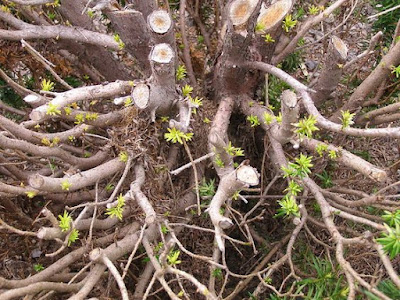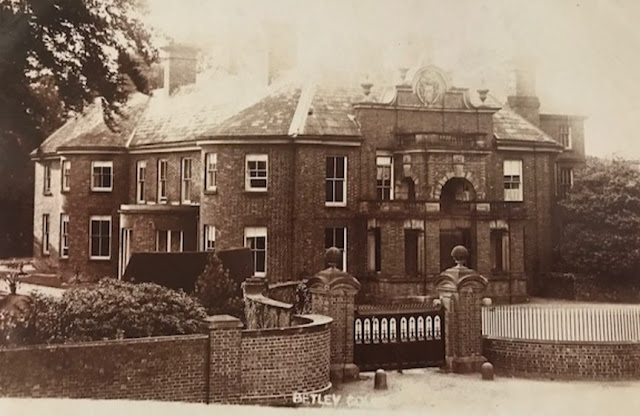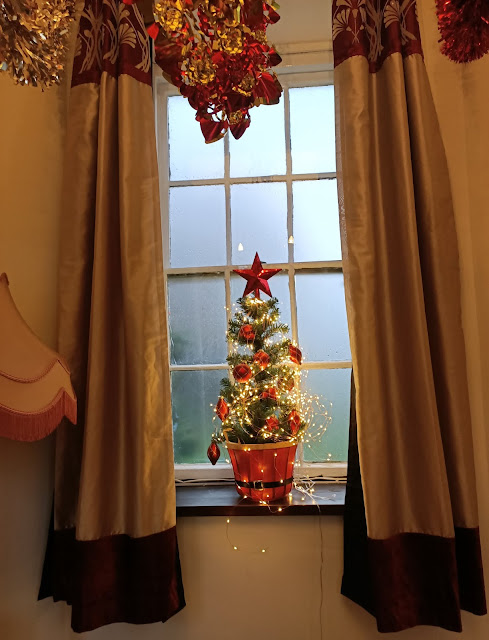A Living Restoration Project
Just over two years ago, I shared a post about William Barron’s yew screen, a topiary hedge feature that grows to the right-hand side of the southern elevation (visible in the postcard above in front of the nearest bow window). For some years, we’d harboured ideas to restore this Victorian feature, as it is somewhat overgrown, and sought advice from the arboriculturists at Royal Botanical Gardens, Kew, and the head gardener at Elvaston Castle. This week, we moved a step closer to starting this process, as an application we submitted to Newcastle-under-Lyme Borough Council was enthusiastically received by their tree department. We’re now working with them to obtain the relevant permissions before we start.
 |
| Barron's yew screen, somewhat overgrown. Pictured in 2019, shortly before the scaffolding was erected. |
Restoring Barrons’ yew screen will be a long process, as the advice we’ve received cautions us to cut back one facet at a time, so as not to shock the yew trees. Ideally, we’d like to make use of the scaffolding before it is dismantled later this year, to get up into the upper boughs of the remaining yew trees and reduce the height of them, to about a foot lower than we’d like the finished hedge feature to be. This will allow light to the lower sections of the hedge, and help stimulate new growth from the trunk. Then, with a gap of a year before each procedure, we will cut back the front, the back and the sides.
 |
| Drastically cut-back yew. Unlike the majority of evergreens, yew will regenerate from old wood. |
Yew (Taxus baccata) really is a forgiving species, and in
drastic circumstances can be cut down to as close as 6” of the ground and still
regenerate. Nigel and I have seen this topiary treatment done to great effect
at the National Trust’s Little Moreton Hall, where restorative pruning was
undertaken some years ago in the knot garden. Although it looked stubbly and
bald for a season or two, the rejuvenating benefits are really beginning to
show. However, it takes some courage to take a saw to an old tree in the hope it will flourish again. It is one of the marvels of yew that it behaves like this, as it will
grow back from the old wood of the trunk, one of the reasons it is so valued
for topiary and hedging. It is exciting to be getting the restoration process
underway. Yew has such an ancient association with death and regeneration that this project seems like a fitting way to mark the rebuild of the house.
Bats in the Belfry
Tonight, we will be undertaking the second bat survey, to establish if we have bats (specifically brown long-eared bats - Plecotus auritus) roosting in part of Betley Court’s roof. Once we know, we can take advice on what actions need to be taken, and get some idea of when our contractors can start again on the roof over Royds House. It will be good to get this part of the project back on track!
 |
| Our expert ecologist, armed with a heat sensing detector as we search for evidence of bats |
 |
| Brown long-eared bat in flight. Photo: Carl Morrow |
House tours.
We’ll be conducting some more restoration tours of Betley
Court in a few weeks (20th & 21st August 2022). This time, we’re focusing on the ground floors of the
main house. This includes the Nash Room, the old silver safe and the
housekeeper’s room – the only room in the house to retain its ornate
plasterwork after the fire. As the rooms have yet to be restored, we’ll be able
to show visitors some of the discoveries we’ve made about the building – for example,
the composite iron beam designed by John Nash, installed in 1810 to create a
more open, lighter drawing room.
 |
| The former family kitchen of the main house (Photo: Darren Washington /Sarah Peart) |
We’ll provide a hard hat and hi-viz jacket. All we ask is
that visitors wear stout shoes, and suitable clothing for a visit to a building
site. Tickets, which can be found by clicking on this link are £10. Visitors
must be over 8 years old. The gardens are open until the gates close at 4.30pm.
Hope to see some of you there!
All best wishes
Ladybird Su



Comments
Post a Comment